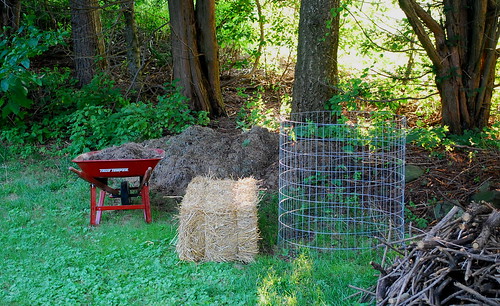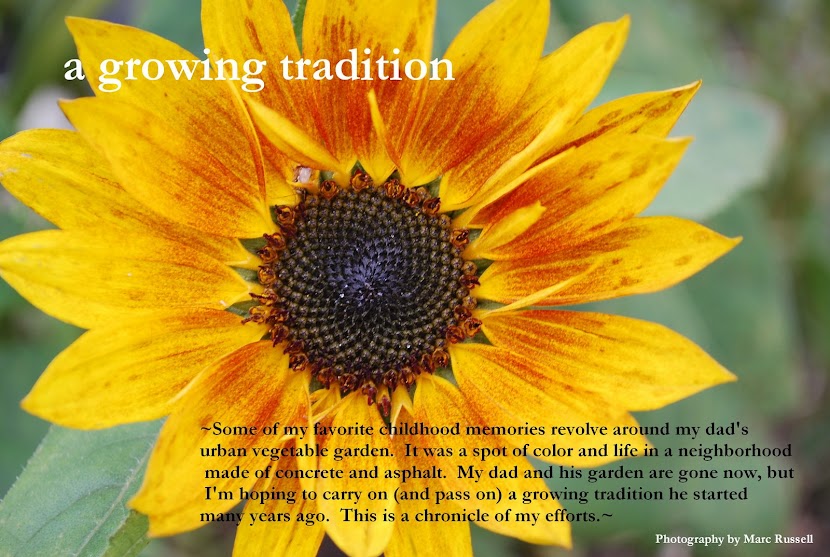
Yesterday, I started my compost pile. I figured I should find a good use for all of the grass clippings we've accumulated in the past month. It's amazing how quickly grass grows, not to mention the amount of effort that goes into maintaining a decent-looking half-acre lawn. It almost doesn't seem worth the trouble (but that's just the gardener inside me talking). Next year, I'm hoping to get most of my "green" material directly from the vegetable garden, however for this year, grass clippings will have to do.
I decided to utilize some leftover 2" by 4" wire mesh (which I used for my fencing) to construct my compost cage. The ring is held together by plastic electrical ties (easy to attach and easy to snip off). It took about 5 minutes to assemble. As far as locations go, I decided to place my compost pile behind the shed under the evergreen trees. This location is out of sight from the house (though I find nothing "ugly" about a compost pile). I figured the evergreens would act a kind of protection from heavy winter snow storms and drifts.
I'm building up my compost pile in layers of brown, green and black. I started off by putting a layer of straw into the cage. I purchased the straw this past weekend for use as a mulch in the garden and as a "brown" in the compost pile. A 50 pound bale was only $9 and more than enough to suit my needs. Adding straw ensures proper drainage and airflow. Then came a layer of grass clippings or "green". Next, I added a layer of grass roots, which I removed from the plot when digging my raised beds. The "black" component comes from the soil that's caked onto these roots and supplies the microbial life that will break down all of this material. Finally, although I forgot to do so yesterday, I will also add a fine layer of greensand and rock phosphate to top things off. So why go through the trouble of building these layers? Eliot Coleman likens this process to that of a smoldering fire. The browns provide the fuel, the greens provide the fire, and the microbial life powers the engine. Evenly distributing these elements ensures that this engine runs smoothly, or at least that's what we hope for.
After I had accumulated several layers of material, I watered the pile well. I will also cover it with a piece of tarp or old carpet to keep it moist. All that's left to do now is to slowly build up this pile and wait for mother nature to do her thing.







Great post Thomas. What benefets do the greensand and rock phosphate add (other than minerals) to the compost process?
ReplyDeleteLast year I added granite meal, alfalfa meal, and Azomite to my new soil. This year I am planning on doing the greensand as well. With so many amendments to chose from (NOFA order) it gets hard to narrow it down. If you do an order check out the Azomite (as in an A to Z multi-vit. for the garden), I credit it for my lack of mineral deficiencies in a first year garden.
The alfalfa meal is a quick inexpensive way to boost Nitrogen levels. Now you have me thinking....I should probably toss some stuff into my compost heap!
Hi Kelly - From what I've read, adding these minerals to the compost as it ages instead of directly into the garden is supposed to make them more readily available for the plants to absorb. It also cuts down on the time one spends prepping the beds.
ReplyDeleteI was considering using alfalfa meal in as a source of nitrogen as well but could only find it in a pelleted form (I guess they feed this to horses). I was afraid that it would attract mice and other rodents. I'm thinking of using crab meal instead. I will definitely check out Azomite! Thanks for the suggestion.
Huh, good to know! Crab meal must be great stuff, it sounds like you have some good store front recources nearby. Good call on the pellets, the hay and straw is enough of a rodent attractor in itself.
ReplyDeleteThanks for the seeds, I am really looking forward to trying them. Oh- and you sent PLENTY!! 8)
ReplyDeleteThomas ... thanks for your note at Dreams and Bones ... it helped me to find you and this energetic summer you have had building your new garden. I am very, very impressed. As for the artichoke overwinter ... again an no-go even with the wall-o-waters. But it WAS a particularly cold winter.
ReplyDeleteKeep up the good work.